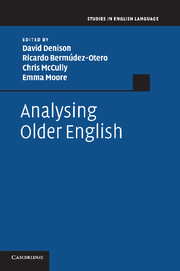Book contents
- Frontmatter
- Contents
- Figures and maps
- Tables
- Contributors
- General introduction
- Part I Metrics and onomastics in older English
- 1 Introduction to Part I
- 2 What explanatory metrics has to say about the history of English function words
- 3 to þære fulan flóde . óf þære fulan flode
- 4 Notes on some interfaces between place-name material and linguistic theory
- Part II Writing practices in older English
- Part III Dialects in older English
- Part IV Sound change in older English
- Part V Syntax in older English
- References
- Index
2 - What explanatory metrics has to say about the history of English function words
Published online by Cambridge University Press: 05 December 2011
- Frontmatter
- Contents
- Figures and maps
- Tables
- Contributors
- General introduction
- Part I Metrics and onomastics in older English
- 1 Introduction to Part I
- 2 What explanatory metrics has to say about the history of English function words
- 3 to þære fulan flóde . óf þære fulan flode
- 4 Notes on some interfaces between place-name material and linguistic theory
- Part II Writing practices in older English
- Part III Dialects in older English
- Part IV Sound change in older English
- Part V Syntax in older English
- References
- Index
Summary
As Old English developed into Middle English, the relative frequency of function words increased significantly, a change often attributed to decay of the inflectional system. When an old dative inflection became indistinct, for example, it seems reasonable to suppose that prepositions like to and for would have been needed as functional indications of the former inflectionally marked grammatical case. The redundancy of human languages makes it difficult to measure the need directly, however. At our present stage of research, it seems perfectly reasonable to turn the familiar account on its head and argue that increased use of function words reduced the functional load on inflections, hastening their demise. It seems likely, in fact, that the analytic tendencies of stricter word order, decay of inflections, and increased use of function words interacted in a cyclical fashion, with each tendency appearing now as cause, now as effect (Traugott 1972: 110–11). Analysis of such a cycle would involve determining what old synthetic feature was lost at a given stage of development and what new analytic feature arose to take its place. Here I will use metrical evidence to identify a sudden increase in the felt need for function words during the late Old English period, just after centralisation had erased all distinctions among inflectional vowels (Fulk 1992: 252). As we shall see, this need played a decisive role throughout the evolution of Middle English metre.
In Beowulf, the predominant Old English verse types identified by Sievers (1893) frequently appear as syntactic structures of exactly two words. These structures appear much less frequently in prose and must have been valued by poets for their metrical properties (Russom 1987: 133–44). In Sir Gawain and the Green Knight, an alliterative poem of the fourteenth century (henceforth SGGK), two-word verses are rare and added function words are actually required by important metrical rules (Cable 1988; Duggan 1988). Added function words had been tolerated as extrametrical syllables in Old English poetry, but subject to many restrictions. Weakening of these restrictions, as formulated within the word-foot theory (Russom 1987, 1998), provides direct evidence of felt need.
- Type
- Chapter
- Information
- Analysing Older English , pp. 15 - 27Publisher: Cambridge University PressPrint publication year: 2011



